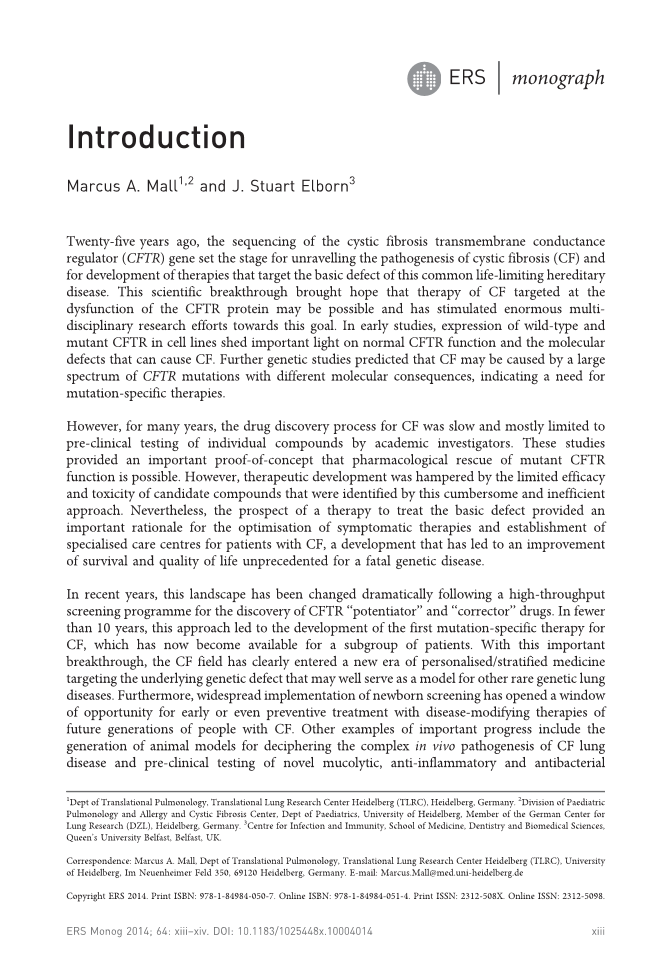ERS | monograph Introduction Marcus A. Mall1,2 and J. Stuart Elborn3 Twenty-five years ago, the sequencing of the cystic fibrosis transmembrane conductance regulator (CFTR) gene set the stage for unravelling the pathogenesis of cystic fibrosis (CF) and for development of therapies that target the basic defect of this common life-limiting hereditary disease. This scientific breakthrough brought hope that therapy of CF targeted at the dysfunction of the CFTR protein may be possible and has stimulated enormous multi- disciplinary research efforts towards this goal. In early studies, expression of wild-type and mutant CFTR in cell lines shed important light on normal CFTR function and the molecular defects that can cause CF. Further genetic studies predicted that CF may be caused by a large spectrum of CFTR mutations with different molecular consequences, indicating a need for mutation-specific therapies. However, for many years, the drug discovery process for CF was slow and mostly limited to pre-clinical testing of individual compounds by academic investigators. These studies provided an important proof-of-concept that pharmacological rescue of mutant CFTR function is possible. However, therapeutic development was hampered by the limited efficacy and toxicity of candidate compounds that were identified by this cumbersome and inefficient approach. Nevertheless, the prospect of a therapy to treat the basic defect provided an important rationale for the optimisation of symptomatic therapies and establishment of specialised care centres for patients with CF, a development that has led to an improvement of survival and quality of life unprecedented for a fatal genetic disease. In recent years, this landscape has been changed dramatically following a high-throughput screening programme for the discovery of CFTR ‘‘potentiator’’ and ‘‘corrector’’ drugs. In fewer than 10 years, this approach led to the development of the first mutation-specific therapy for CF, which has now become available for a subgroup of patients. With this important breakthrough, the CF field has clearly entered a new era of personalised/stratified medicine targeting the underlying genetic defect that may well serve as a model for other rare genetic lung diseases. Furthermore, widespread implementation of newborn screening has opened a window of opportunity for early or even preventive treatment with disease-modifying therapies of future generations of people with CF. Other examples of important progress include the generation of animal models for deciphering the complex in vivo pathogenesis of CF lung disease and pre-clinical testing of novel mucolytic, anti-inflammatory and antibacterial 1 Dept of Translational Pulmonology, Translational Lung Research Center Heidelberg (TLRC), Heidelberg, Germany. 2 Division of Paediatric Pulmonology and Allergy and Cystic Fibrosis Center, Dept of Paediatrics, University of Heidelberg, Member of the German Center for Lung Research (DZL), Heidelberg, Germany. 3 Centre for Infection and Immunity, School of Medicine, Dentistry and Biomedical Sciences, Queen’s University Belfast, Belfast, UK. Correspondence: Marcus A. Mall, Dept of Translational Pulmonology, Translational Lung Research Center Heidelberg (TLRC), University of Heidelberg, Im Neuenheimer Feld 350, 69120 Heidelberg, Germany. E-mail: Marcus.Mall@med.uni-heidelberg.de Copyright ERS 2014. Print ISBN: 978-1-84984-050-7. Online ISBN: 978-1-84984-051-4. Print ISSN: 2312-508X. Online ISSN: 2312-5098. ERS Monog 2014 64: xiii–xiv. DOI: 10.1183/1025448x.10004014 xiii
